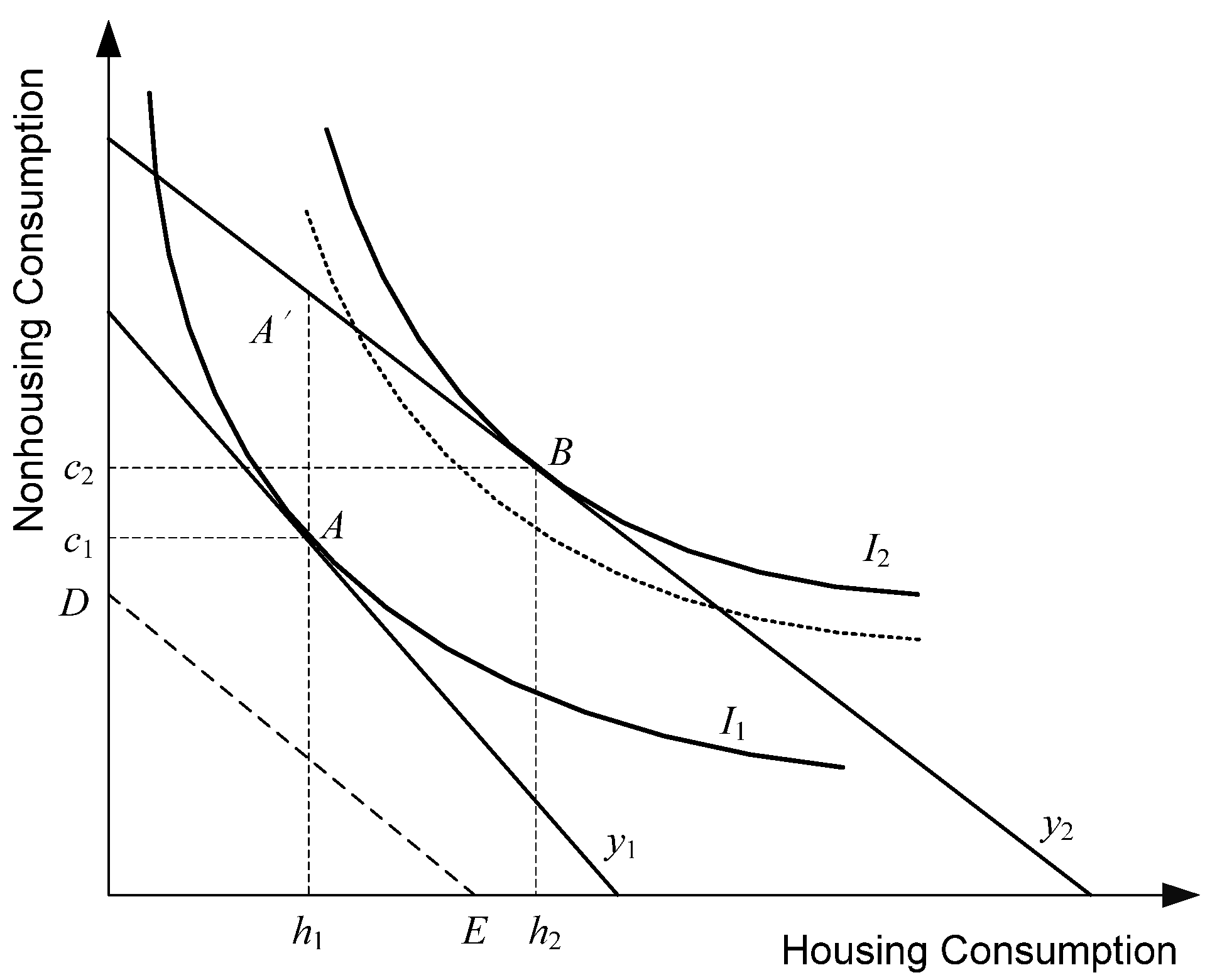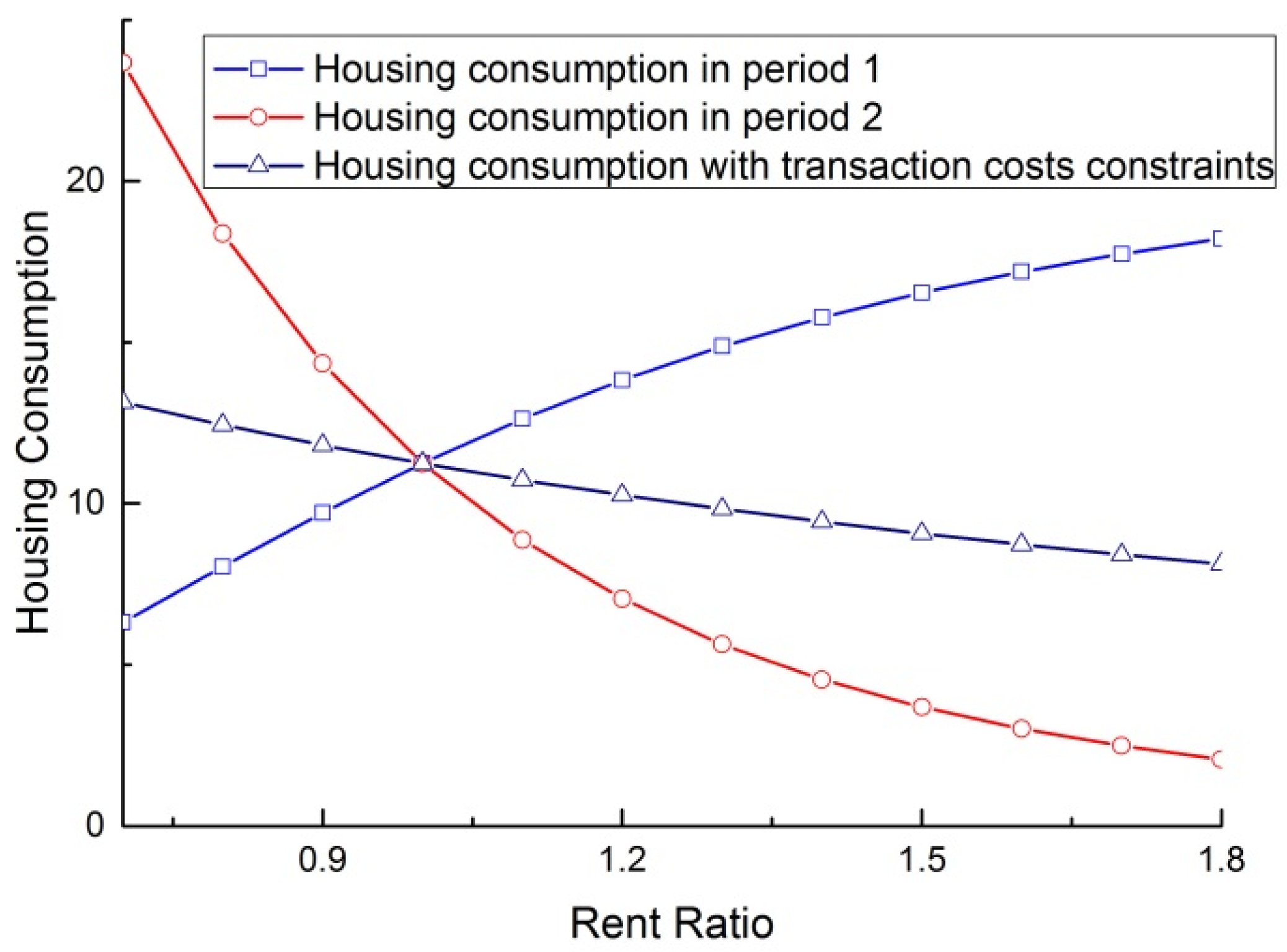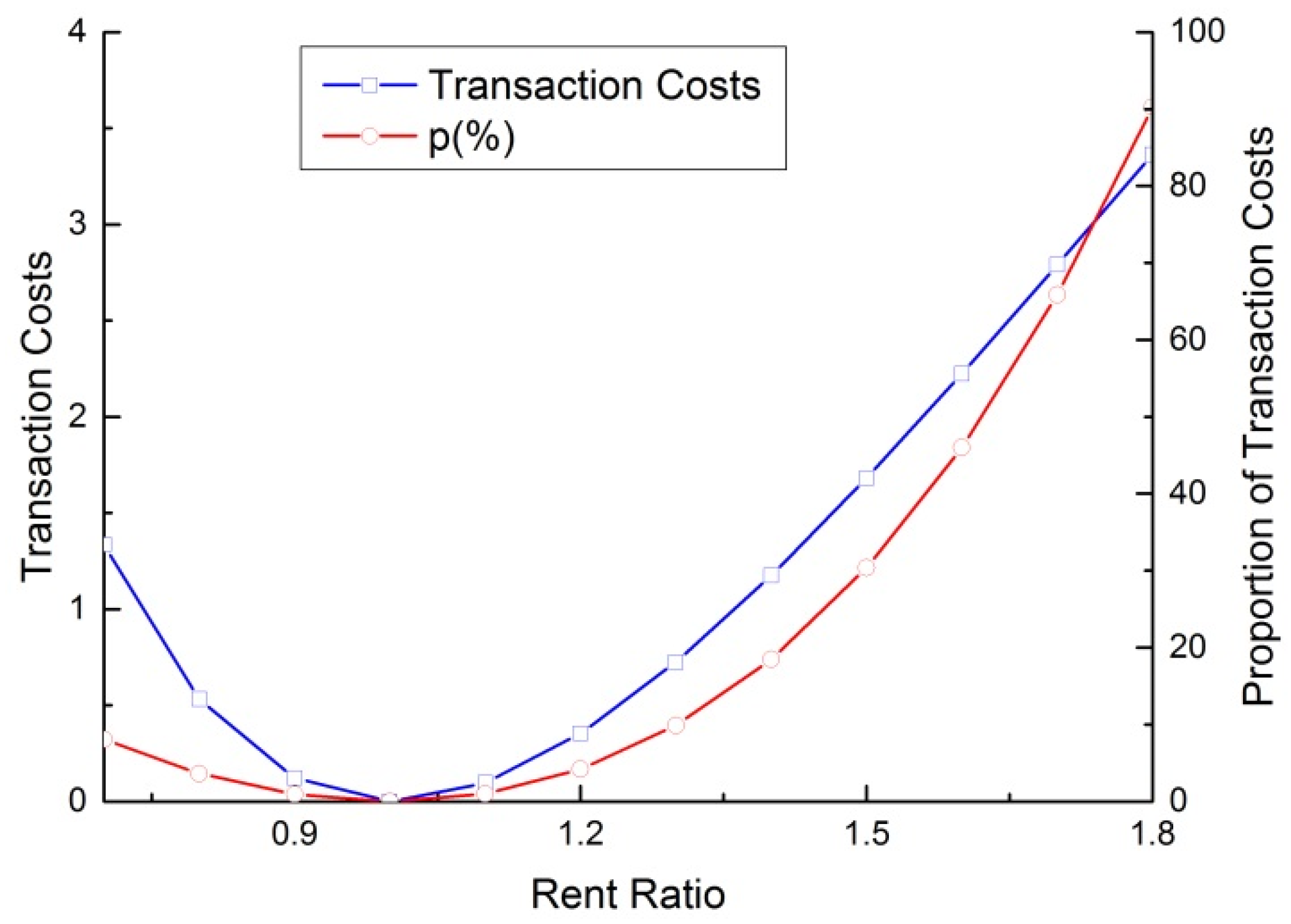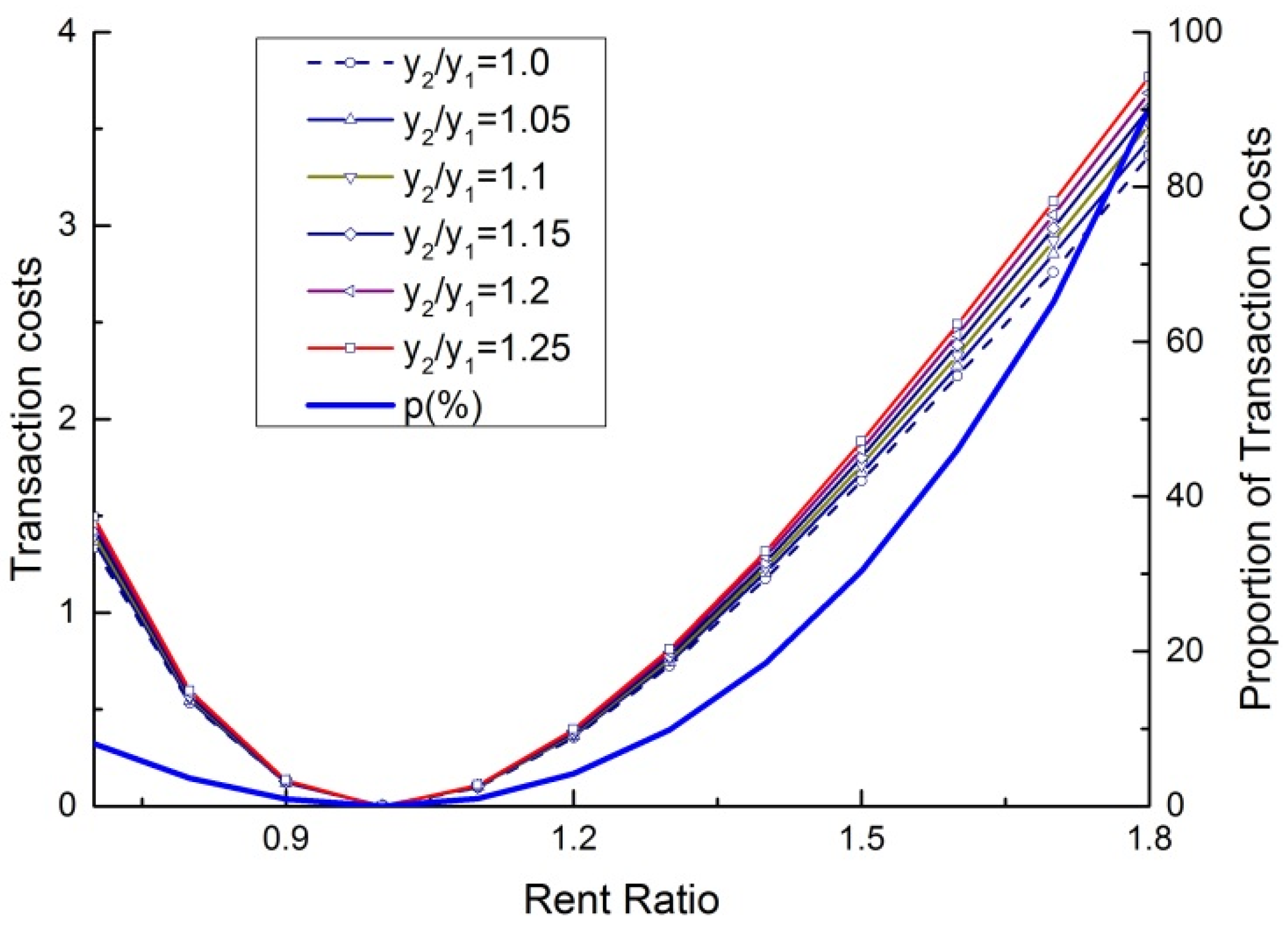Simulating the Barriers of Transaction Costs to Public Rental Housing Exits: The Case of Wuhan, China
Abstract
1. Introduction
2. Literature Review
3. Methodological Approach
4. Data Description and Simulation Methods
5. Simulation Barriers of Transaction Costs to the Public Rental Housing Exit
5.1. Barriers of Transaction Costs with Changes in Housing Rent
5.2. Barriers of Transaction Costs under Changes in Rent and Income
6. Conclusions
Author Contributions
Acknowledgments
Conflicts of Interest
References
- Li, K. Implementing the massive-scale public housing program and improving housing policy and housing provision system step-by-step. Qiu Shi 2011, 53, 3–8. (In Chinese) [Google Scholar]
- CPGC. The Goal of 36 Million Sets of Affordable Housing in 12th Five-Year Plan is Expected to Exceed the Target. Available online: http://www.gov.cn/xinwen/2015-03/08/content_2830485.htm (accessed on 12 May 2016). (In Chinese)
- Gao, B. Improving the mechanism of indemnificatory housing distribution and exit. Mod. Urban Res. 2012, 27, 29–31. (In Chinese) [Google Scholar]
- NAOC. Real-Time Audit Results of Government-Subsidized Housing Projects in 2015 (General Serial No. 240). Available online: http://www.audit.gov.cn/en/n746/n752/n996/c96598/content.html (accessed on 12 December 2016).
- Deng, H.Q.; Wang, Y.B. Research on the exit mechanism of rental housing based on evolutionary game theory. Guizhou Soc. Sci. 2015, 303, 123–127. (In Chinese) [Google Scholar]
- MOHURD. Guidance on the Household Rental Subsidy for Secure Urban Housing. Available online: http://www.mohurd.gov.cn/wjfb/201701/t20170110_230264.html (accessed on 28 February 2017).
- Hooimeijer, P.; Oskamp, A. A simulation model of residential mobility and housing choice. J. Hous. Built. Environ. 1996, 11, 313–336. [Google Scholar] [CrossRef]
- Peteke, F.; Maarten, V.H. Neighbourhood change ... reason to leave? Urban Stud. 2009, 46, 2103–2122. [Google Scholar]
- Huang, Y.Q.; Deng, F.F. Residential mobility in Chinese cities: A longitudinal analysis. Hous. Stud. 2006, 21, 625–652. [Google Scholar] [CrossRef]
- Fang, Y.H.; Zhang, R. Problems and resolution ways to the exit mechanism of China’s indemnificatory housing. Urban Probl. 2013, 220, 79–83. (In Chinese) [Google Scholar]
- Li, J.T.; Wang, C.C.; Sun, J. Empirical analysis of tenants’ intention to exit public rental housing units based on the Theory of Planned Behavior—The case of Wuhan, China. Habitat Int. 2017, 69, 27–36. [Google Scholar] [CrossRef]
- Pan, H.Y.; Zeng, Y.W.; Sun, Q.; Zhang, S.; Lin, J.W.; Zhang, X.M. Research on the tenants’ willingness to vacate public rental housing and countermeasures: A case study of Chongqing. Constr. Econ. 2015, 36, 103–107. (In Chinese) [Google Scholar]
- Rossi, P.H. Why Families Move: A Study in the Social Psychology of Urban Residential Mobility; Free Press: Glencoe, IL, USA, 1955. [Google Scholar]
- Li, P.; Tu, Y. Behaviors on intra-urban residential mobility: A review and implications to future research. In IRES Working Paper Series; IRES2011-020; IRES: Singapore, 2011; Available online: http://www.ires.nus.edu.sg/workingpapers/IRES2011-020.pdf (accessed on 19 May 2016).
- Weisbrod, G.; Vidal, A. Housing search barriers for low-income renters. Urban Aff. Q. 1981, 16, 465–482. [Google Scholar] [CrossRef]
- De Groot, C.; Mulder, C.H.; Manting, D. Intentions to move and actual moving behaviour in the netherlands. Hous. Stud. 2011, 26, 307–328. [Google Scholar] [CrossRef]
- Lu, M. Analyzing migration decisionmaking: Relationships between residential satisfaction mobility intentions and moving behavior. Environ. Plan. A 1998, 30, 1473–1495. [Google Scholar] [CrossRef]
- Baker, E.L. Public Housing Tenant Relocation: Residential Mobility, Satisfaction, and the Development of a Tenant’s Spatial Decision Support System. Ph.D. Thesis, The University of Adelaide, Adelaide, Australia, 2002. [Google Scholar]
- Weinreb, L.; Rog, D.J.; Henderson, K.A. Exiting shelter: An epidemiological analysis of barriers and facilitators for families. Soc. Serv. Rev. 2010, 84, 597–614. [Google Scholar] [CrossRef] [PubMed][Green Version]
- Rosenblatt, P.; Deluca, S. “We don’t live outside, we live in here”: Neighborhood and residential mobility decisions among low-income families. City Community 2012, 11, 254–284. [Google Scholar] [CrossRef]
- Kleit, R.G.; Galvez, M. The location choices of public housing residents displaced by redevelopment: Market constraints, personal preferences, or social information? J. Urban Aff. 2011, 33, 375–407. [Google Scholar] [CrossRef]
- Kim, J.H.; Pagliara, F.; Preston, J. The intention to move and residential location choice behaviour. Urban Stud. 2005, 42, 1621–1636. [Google Scholar] [CrossRef]
- Goodman, A.C. A dynamic equilibrium model of housing demand and mobility with transactions costs. J. Hous. Econ. 1995, 4, 307–327. [Google Scholar] [CrossRef]
- Harmon, O.R.; Potepan, M.J. Housing adjustment costs: Their impact on mobility and housing demand elasticities. Real Estate Econ. 1988, 16, 459–478. [Google Scholar] [CrossRef]
- Goodman, A.C. Modeling and computing transactions costs for purchasers of housing services. Real Estate Econ. 1990, 18, 1–21. [Google Scholar] [CrossRef]
- Sánchez, A.C.; Andrews, D. To move or not to move: What drives residential mobility rates in the OECD. In OECD Economics Department Working Papers; No. 846; OECD Publishing: Paris, France, 2011. [Google Scholar]
- Yang, Z.; Chen, J. Housing Affordability and Housing Policy in Urban China; Springer: Berlin, Germany, 2014. [Google Scholar]
- Xie, N. Information Search and Invisible Transaction Cost in the Housing Market; Economic Science Press: Beijing, China, 2014. (In Chinese) [Google Scholar]
- Zhang, H.; Zhang, X.G.; Lu, J.P.; Lin, Y.; Wang, M. Information Economics of Housing Market; Tsinghua University Press: Beijing, China, 2013. (In Chinese) [Google Scholar]
- Zheng, S.Q. A Microeconomic Analysis of Housing Demand in China; China Architecture and Building Press: Beijing, China, 2007. (In Chinese) [Google Scholar]
- Coley, R.L.; Kull, M.; Leventhal, T.; Lynch, A.D. Profiles of housing and neighborhood contexts among low-income families: Links with children’s well-being. Cityscape 2014, 16, 41–64. [Google Scholar]
- Linneman, P.; Wachter, S.M. The impacts of borrowing constraints on homeownership. Real Estate Econ. 1989, 17, 389–402. [Google Scholar] [CrossRef]
- Kleit, R.G.; Kang, S.; Scally, C.P. Why do housing mobility programs fail in moving households to better neighborhoods. Hous. Policy Debate 2016, 26, 188–209. [Google Scholar] [CrossRef]
- Ritsila, J.; Ovaskainen, M. Migration and regional centralization of human capital. Appl. Econ. 2001, 33, 317–325. [Google Scholar] [CrossRef]
- Morrison, P.S.; Clark, W.A.V. Why do they stay? Loss aversion and duration of residence. In California Center for Population Research On-Line Working Paper Series; CCPR: Los Angeles, CA, USA, 2015. [Google Scholar]
- Nepal, B.; Tanton, R.; Harding, A. Measuring housing stress: How much do definitions matter? Urban Policy Res. 2010, 28, 211–224. [Google Scholar] [CrossRef]
- Kahneman, D. Thinking, Fast and Slow; Farrar Straus and Giroux: New York, NY, USA, 2011. [Google Scholar]
- Engelhardt, G.V. Nominal loss aversion, housing equity constraints, and household mobility: Evidence from the United States. J. Urban Econ. 2003, 53, 171–195. [Google Scholar] [CrossRef]
- Bartik, T.J.; Butler, J.S.; Liu, J. Maximum score estimates of the determinants of residential mobility: Implications for the value of residential attachment and neighborhood amenities. J. Urban Econ. 1992, 32, 233–256. [Google Scholar] [CrossRef]
- Quigley, J.M. Transactions costs and housing markets. In Berkeley Program on Housing and Urban Policy, Working Paper Series; No. W02-005; University of California: Berkeley, CA, USA, 2002. [Google Scholar]
- Kan, K. Expected and unexpected residential mobility. J. Urban Econ. 1999, 45, 72–96. [Google Scholar] [CrossRef]
- Wiesel, I.; Pawson, H. Why do tenants leave social housing? Exploring residential and social mobility at the lowest rungs of Australia’s socioeconomic ladder. Aust. J. Soc. Issues 2015, 50, 397–417. [Google Scholar] [CrossRef]
- Barrett, A.; Mosca, I. The psychic costs of migration: Evidence from Irish return migrants. J. Popul. Econ. 2013, 26, 483–506. [Google Scholar] [CrossRef]




| r2/r1 | Period 1 | Period 2 | s | U1 | ||
|---|---|---|---|---|---|---|
| h1 | c1 | h2 | c2 | |||
| 0.7 | 6.32 | 14.76 | 23.67 | 38.66 | 16.42 | 30.73 |
| 0.8 | 8.05 | 18.78 | 18.38 | 34.31 | 10.67 | 29.99 |
| 0.9 | 9.71 | 22.66 | 14.34 | 30.12 | 5.12 | 29.44 |
| 1.0 | 11.25 | 26.25 | 11.25 | 26.25 | 0.00 | 29.01 |
| 1.1 | 12.63 | 29.46 | 8.88 | 22.78 | −4.59 | 28.67 |
| 1.2 | 13.84 | 32.28 | 7.05 | 19.73 | −8.62 | 28.41 |
| 1.3 | 14.88 | 34.72 | 5.64 | 17.10 | −12.10 | 28.21 |
| 1.4 | 15.78 | 36.81 | 4.54 | 14.84 | −15.09 | 28.04 |
| 1.5 | 16.54 | 38.60 | 3.69 | 12.92 | −17.64 | 27.91 |
| 1.6 | 17.19 | 40.11 | 3.02 | 11.28 | −19.81 | 27.80 |
| 1.7 | 17.75 | 41.41 | 2.49 | 9.88 | −21.65 | 27.71 |
| 1.8 | 18.22 | 42.51 | 2.07 | 8.69 | −23.22 | 27.64 |
| r2/r1 | U3 | Period 1 | Period 2 | s | t | p1 (%) | |||
|---|---|---|---|---|---|---|---|---|---|
| h1 | c1 | h2 | c2 | ||||||
| 0.7 | 30.25 | 13.15 | 6.22 | 14.51 | 23.27 | 38.00 | 16.78 | 1.33 | 8.05 |
| 0.8 | 29.81 | 12.45 | 8.00 | 18.66 | 18.26 | 34.08 | 10.85 | 0.53 | 3.62 |
| 0.9 | 29.40 | 11.82 | 9.70 | 22.63 | 14.32 | 30.08 | 5.17 | 0.12 | 0.94 |
| 1.0 | 29.01 | 11.25 | 11.25 | 26.25 | 11.25 | 26.25 | 0.00 | 0.00 | 0.00 |
| 1.1 | 28.64 | 10.73 | 12.61 | 29.43 | 8.86 | 22.75 | −4.54 | 0.10 | 0.99 |
| 1.2 | 28.30 | 10.26 | 13.77 | 32.14 | 7.02 | 19.64 | −8.41 | 0.35 | 4.18 |
| 1.3 | 27.97 | 9.83 | 14.74 | 34.40 | 5.58 | 16.94 | −11.64 | 0.72 | 9.88 |
| 1.4 | 27.66 | 9.44 | 15.54 | 36.26 | 4.47 | 14.62 | −14.30 | 1.17 | 18.47 |
| 1.5 | 27.37 | 9.07 | 16.18 | 37.76 | 3.61 | 12.64 | −16.45 | 1.68 | 30.37 |
| 1.6 | 27.09 | 8.73 | 16.52 | 38.97 | 2.93 | 10.96 | −18.17 | 2.22 | 46.03 |
| 1.7 | 26.82 | 8.42 | 17.10 | 39.92 | 2.40 | 9.53 | −19.53 | 2.79 | 65.87 |
| 1.8 | 26.57 | 8.13 | 17.43 | 40.67 | 1.98 | 8.32 | −20.60 | 3.36 | 90.27 |
| r2/r1 | y2/y1 | U3 | Period 1 | Period 2 | t | p (%) | ||
|---|---|---|---|---|---|---|---|---|
| h1 | c1 | h2 | c2 | |||||
| 0.7 | 1.00 | 30.25 | 6.22 | 14.51 | 23.27 | 38.00 | 1.33 | 8.05 |
| 1.05 | 30.91 | 6.37 | 14.85 | 23.82 | 38.91 | 1.37 | 8.05 | |
| 1.10 | 31.56 | 6.52 | 15.20 | 24.38 | 39.83 | 1.40 | 8.05 | |
| 1.15 | 32.21 | 6.67 | 15.55 | 24.94 | 40.74 | 1.43 | 8.05 | |
| 1.20 | 32.86 | 6.81 | 15.90 | 25.50 | 41.65 | 1.46 | 8.05 | |
| 1.25 | 33.51 | 6.96 | 16.25 | 26.06 | 42.57 | 1.49 | 8.05 | |
| 1.0 | 1.00 | 29.01 | 11.25 | 26.25 | 11.25 | 26.25 | 0.00 | 0.00 |
| 1.05 | 29.63 | 11.52 | 26.88 | 11.52 | 26.88 | 0.00 | 0.00 | |
| 1.10 | 30.26 | 11.79 | 27.51 | 11.79 | 27.51 | 0.00 | 0.00 | |
| 1.15 | 30.88 | 12.06 | 28.14 | 12.06 | 28.14 | 0.00 | 0.00 | |
| 1.20 | 31.51 | 12.33 | 28.77 | 12.33 | 28.78 | 0.00 | 0.00 | |
| 1.25 | 32.13 | 12.60 | 29.40 | 12.60 | 29.41 | 0.00 | 0.00 | |
| 1.7 | 1.00 | 26.82 | 17.10 | 39.92 | 2.40 | 9.53 | 2.79 | 65.87 |
| 1.05 | 27.40 | 17.52 | 40.88 | 2.46 | 9.76 | 2.86 | 65.87 | |
| 1.10 | 27.98 | 17.93 | 41.85 | 2.52 | 9.99 | 2.92 | 65.87 | |
| 1.15 | 28.56 | 18.35 | 42.81 | 2.58 | 10.22 | 2.99 | 65.87 | |
| 1.20 | 29.13 | 18.76 | 43.76 | 2.63 | 10.45 | 3.06 | 65.87 | |
| 1.25 | 29.71 | 19.17 | 44.72 | 2.69 | 10.67 | 3.12 | 65.87 | |
| p (%) | r2/r1 | |
|---|---|---|
| Lower | Upper | |
| 8 | 0.701 | 1.267 |
| 9 | 0.685 | 1.285 |
| 10 | 0.669 | 1.301 |
| 11 | 0.653 | 1.313 |
| 12 | 0.637 | 1.325 |
© 2018 by the authors. Licensee MDPI, Basel, Switzerland. This article is an open access article distributed under the terms and conditions of the Creative Commons Attribution (CC BY) license (http://creativecommons.org/licenses/by/4.0/).
Share and Cite
Li, J.; Ning, X.; Sun, J.; Xiong, X. Simulating the Barriers of Transaction Costs to Public Rental Housing Exits: The Case of Wuhan, China. Sustainability 2018, 10, 1549. https://doi.org/10.3390/su10051549
Li J, Ning X, Sun J, Xiong X. Simulating the Barriers of Transaction Costs to Public Rental Housing Exits: The Case of Wuhan, China. Sustainability. 2018; 10(5):1549. https://doi.org/10.3390/su10051549
Chicago/Turabian StyleLi, Jintao, Xin Ning, Jun Sun, and Xiaoqian Xiong. 2018. "Simulating the Barriers of Transaction Costs to Public Rental Housing Exits: The Case of Wuhan, China" Sustainability 10, no. 5: 1549. https://doi.org/10.3390/su10051549
APA StyleLi, J., Ning, X., Sun, J., & Xiong, X. (2018). Simulating the Barriers of Transaction Costs to Public Rental Housing Exits: The Case of Wuhan, China. Sustainability, 10(5), 1549. https://doi.org/10.3390/su10051549




